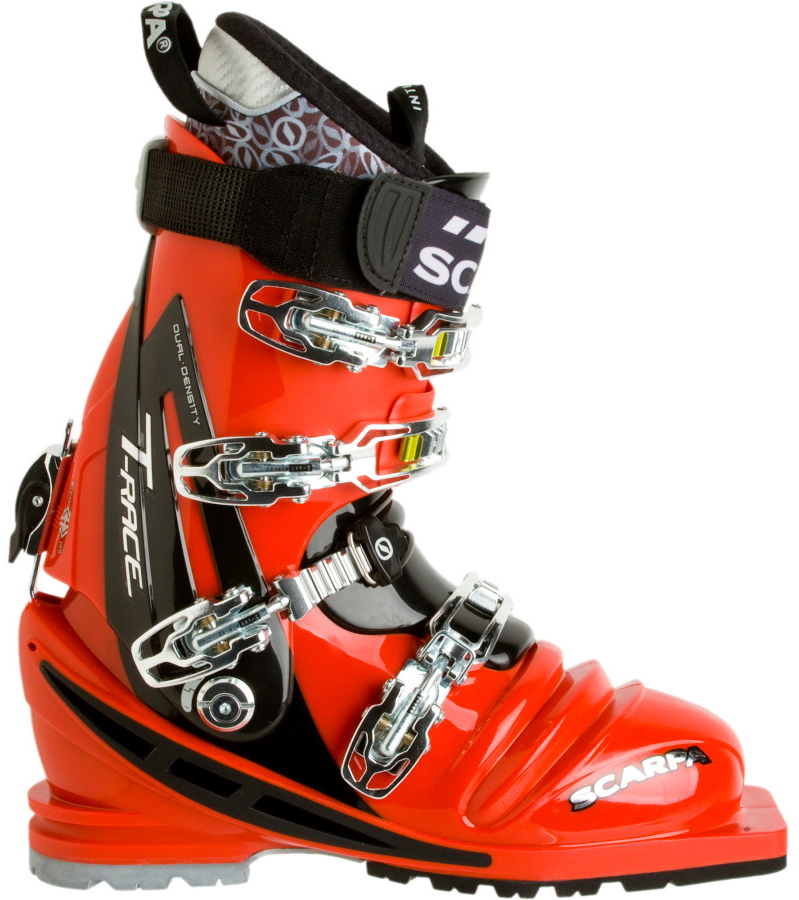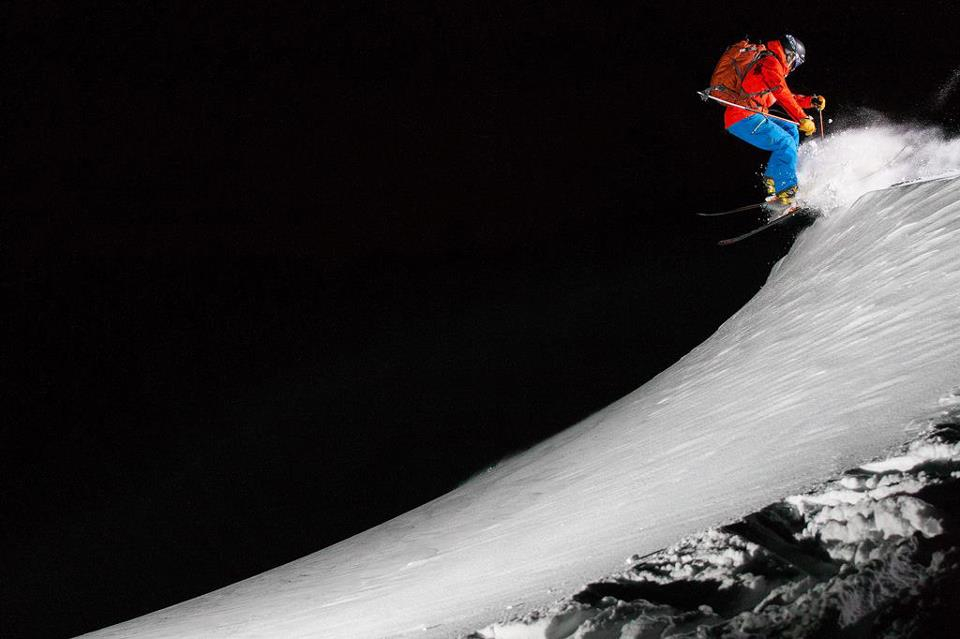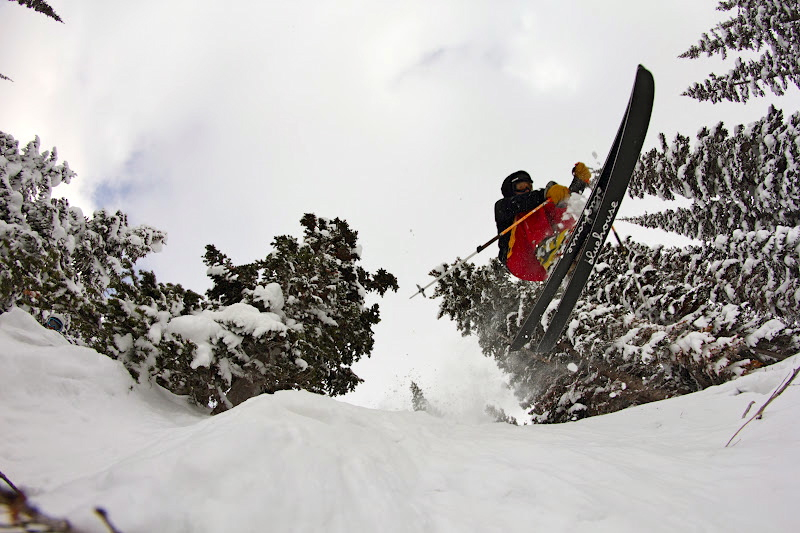
Scarpa T-Race vs Scarpa Tx Comp
Scarpa T-Race
SPECS
· Inner Boot: Intuition Speed Pro G Tele
· Shell | Cuff | Tongue: 100% Pebax®
· Range of Motion: 22°
· Forefoot Last Width: 100mm
· Buckles: 4 + Active Power Strap
· Forward Lean: 9° – 12°
· Sole: Vibram® Escape
· Weight: 1982g; 4lbs 6oz (1/2 pair size 27)
· Sizes: 22.5 – 31

Scarpa Tx Comp
SPECS
· Inner Boot: Intuition Speed Pro G
· Shell | Cuff | Tongue: 100% Pebax®
· Range of Motion: 22°
· Buckles: 4 + Power Strap
· Forward Lean: 10° – 15°
· Sole: Vibram® Evo
· Weight: 1708g; 3lbs 12oz (1/2 pair size 27)
· Sizes: 22.5 – 30
· Binding System: NTN
· Forefoot Last Width: 102mm
In the first part of our discussion of NTN bindings and boots, I talked in general terms about the boot situation in the NTN world. Now, I want to compare the Scarpa T-Race (the 75mm benchmark boot for the aggressive teleskier) to the NTN-compatible Scarpa Tx Comp. I’ve put in over 300 days each on the Scarpa Tx Comp (NTN) and the Scarpa T-Race (75 mm), so the aim of this review is to A/B two of the most aggressive boots in their respective platforms and explain their similarities and differences.

From a fit standpoint, Scarpa hasn’t changed the Tx Comp since 2011, and the T-Race since before 2009-10. The evolution of T-Race has come to rest at a very solid design that is highly functional, durable, comfortable, versatile, if not quite perfect. So how do these two boots line up? If you have ridden the T-Race and are stoked on it, will you be stoked on the Tx Comp? The answer is “most likely,” but there are some differences that need to be pointed out.
Duck Bill
The most noticeable difference between the T-Race and the Tx Comp is the lack of duck bill on the toe of the Tx Comp. It’s like walking in a normal ski boot, only with bellows. It’s a little weird at first, but you get used to it. The only draw back I’ve found is not having that nice big piece of rubber to dig into the snow and stand on when you’re setting the boot pack up a steep face or couloir. But, again, the benefit of having the NTN binding far outweighs this loss in my experience.
Vibram Sole
Both boots employ a Vibram sole that grips just about anything but smooth east coast ice. The only difference here is, again, the lack of duck bill extension on the toe. But I’ve felt even more secure in the parking lot and hiking Superior’s ridge in the Tx Comp because it feels like the weight distribution is placed more evenly without that big piece of rubber on my toe.
Weight
The Tx Comp is noticeably lighter than the T-Race. The Tx Comp weighs in at 1708 grams per boot, while the T-Race weighs 1982 grams. This is mostly due to the loss of the heavy rubber on the toe that made up the duck bill. The new reversed duck bill is much smaller.
Toe Box
The toe boxes of these two boots feel very different. The Tx Comp’s 102mm-last makes a huge difference in fit compared to the T-Races 100mm. I’m not the only one who feels this way. Reviewer Paul Forward commented, “Totally agree. The Scarpa NTN boots fit like Kleenex boxes.” While I wouldn’t go that far, there is definitely more room in the toe box of the Tx Comp.”
With the T-Race, from the moment I put the boot on, my toes felt secure and properly fitted. I’ve even been through two pairs of liners in them, and experienced no change in terms of fit.
On the other hand, I’ve been through two pairs of Tx Comps in two different sizes (which I’ll address in the next section) and as many pairs of liners later, I still have yet to dial in the toe box.
Too much room in the toe box translates to a diminished transfer of energy to get on edge, which undermines one of the benefits that the NTN binding brings to the table. Teleskiers need to be able to squash that back pinkie toe and slam the down hill big toe in order to carve hard. Doing so will really open up the NTN binding’s power.
Again, this may merely be an issue for me that you may not experience yourself if 102mm last is where your foot is comfortable, so it isn’t meant to discourage you from the Tx Comp. But after so much time in this boot I thought it was worth mentioning as I think this is one area that Scarpa could look at improving the Tx Comp.
Liner
The Intuition Speed Pro G Liner come stock with both boots. It’s functional and comfortable. I tend to pack them out by the end of one season (~100 days) and only really mold them once or twice.
Sizing
I have ridden both the 24.5 and the 24.0 in the Tx Comp and the 25.0 in the T-Race. I initially thought the 24.5 was too big for my foot, but after riding the 24.0 I have concluded the 24.0 is too small. If you are racing or competing, then slamming your toes into the front of your boot in the name of control might make sense. But for those of us who live in our boots, tour in them, après in them, I’d recommend going with your street shoe size.
The T-Race 25.0 has fit me great from the moment I put it on, and while I’ve never had the option to try another size I’ve never felt the desire to, either. So again, my recommendation is to go with your street shoe size, especially if you are fond of your toenails.


If you are still thinking your pinky toe is the Holy Grail of Telly turns, you need more lessons.
Hey Superman,
Anytime you want to go take turns, I’m game. Don’t think that me and my pinky toe won’t smoke you. Don’t worry I’ll tell Bruce Wayne to leave the batmobile in the cave.
Best, The Boy Wonder.
The funny thing is that the 24.5 and 25.0 are exactly the same size. The shells and liners are identical; it’s just marketing to suggest there’s any difference. Ever try to get a replacement liner from Intuition? They offer only whole sizes.
Hey Boot Fitter,
Thanks for pointing that out, there was a typo in there! We’ve fixed it and you’re absolutely correct. The 25.0 and 24.5 shells are the exact same and it is the liner that is the difference between the two sizes. In fact I have ridden the 24.5 and 24.0 in the TxComps and have found the 24.0 shell to be too small. Thanks again!
I am switching to NTN and need to buy boots. Trying to decide between the Scarpa TX Comp and Crispi World cup. I have been very happy with my Garmont Ener-g. I know the bellows are different and am worried the Crispi may flex very differently than my old boots. Anyway, I have to make a decision soon and was looking for input.
Darrell,
This is the question I have been trying to answer for the last 5 seasons, to no avail. The many requests I have made to Crispi to ride their boots have gone unanswered. Either they don’t feel confident enough to put the World Cup or Evo up against the TxComp or they don’t care. Regardless, you my friend have come to the same place that all charging tele skiers find themselves and I apologize for not being able to help you, but know it is not for lack of trying.
I can speak to the Scarpa TxComp vs. the Ener-g for you though. I rode the Ener-g for 6 seasons and, like you, loved them. They are, however, much different than the TxComp. The TxComp has stiffer bellows and a lower boot cuff and are a much more aggressive boot than the Ener-g. Also, while wider than they used to be, the TxComp will still feel narrower than the Ener-g. The NTN binding is already much more stable than any 75mm binding and has the potential to be stiffer as well (though you can ride with green cartridges if you like the “softer” feel) so going to a stiffer boot and binding may be more change than you’re looking for.
If you are stoked on your Ener-g boot then I would push you towards the Scott Voodo NTN boot. The Voodo is the 3 buckle version of the Syner-g, which has now replaced the Ener-g in Scott’s line up. (I’m assuming that you know that Scott bought Garmont). You’re looking at a lower boot cuff, one less buckle, but a similar flex and width. In short the Voodo is the closest NTN match to the Ener-g. As you know, the TxComp is amazing, it just may not be the boot you’re looking for.
I hope this helps, let me know if you have any other questions and congrats on the jump! Best, Robin.
I just got the Scarpa TX Pro in the 27.5 and the toe box is insanely roomy. I have been skiing the Scarpa T1 the last 10 years in 27.0 and had to wear the thinnest sock liners I could find and trim my toenails to the nubs. That’s why I jumped up to 27.5 in the TX Pro. Rest of boot feels sized right – any recommendations on what I can do? Anything with the Intuition liner when I heat set them? Or is only option sizing down to 27.0?
Same question as Brian… exactly.
Sizing note to help others. I have been skiing T1 for years. The last pair is the black and red four buckle size 27. I have had the toe box expanded and use the thinnest orthodic, and really tried to get the liner as thin as possible when refitting it, Liner is super thin in the toe and heal. They are still super snug, but I love the way they perform. Moving to NTN, tried (but not skied) on the NTN Pro size 27 and I am excited as I think they will fit me out of the box due to the wider last.
Only question is: NTN Pro or NTN Comp. If I have been skiing the T1 for years and have been very happy with them would the NTN Pro be more similar to the T1. Note: approaching mid 50’s. Probably don’t need to be skiing on bricks and want to tour a little in them as well.
Hey TelePK,
I’m 54, tele last three decades. Enjoying T1s for years, I found the NTN Pro to be softer and better for my style and body size. Now I have a new pair of NTN Comps (6 days) which recall the bellows feel of fresh T1s. The Comps are now my favorites, and while still a touch stiff for me, are breaking in nicely at the bellows, and I’ve reduced the binding preload some to my liking.
The Comps give bellows-located springiness, and stronger ski tip engagement. The Pros offer nice bellows suppleness, almost leather like in comparison, and a centered engagement of the ski depending more on lateral and rotary forces than tip driving. The difference in skiing is due to the bellows, the lateral and rear flex seems about the same to me. The Comp is snappy, fun, and fast. A better boot to lean on in high pressure turns, the Comp is more shin-pressure-oriented. The Pro is supple, poised, and neutral. A better boot for really feeling the skis underfoot (for me, at 150 pounds), the Pro is more foot-pressure-oriented. Hope this makes sense.
The Comps lack tech inserts and so are a couple ounces lighter than the Pros. The current buckles are better, lighter than on your T1s. I’m taking the Comps touring this year, but either model would be fine. (Re: bindings… I recommend Rottefella Freeride, but love the amazing 22 Designs Outlaw/Outlaw X, which does it all with power and smoothness. If you want to use tech toe tele bindings, the Pro is the only choice from Scarpa.)